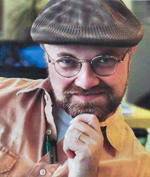By Eric George Tauber

SAN DIEGO –“Each of us thinks we’re unique. But we’re somebody else’s stereotype.” -Sam Woodhouse
Before Honky opened, the REP was accused of being racist for staging a show with such a racially charged title. Somebody even stole the poster from the REP’s front window –a first in their history. These are the kinds of knee-jerk reactions you get when you mount a comedy about racism.
When you walk into the Lyceum Space Theatre, you are greeted by a completely gray set of layered panels. And gray is the world of Honky: the gray area between right and wrong, between stereotypes and demographics, between a tragedy and an opportunity. And then Sean Fanning’s set surprises us with opening doors and turning panels, revealing a much more complex world than we realized.
To sell basketball shoes, Peter created a commercial that effectively glorified urban violence, using “Sup now?” as a catchphrase. When a young black man is killed for his shoes, and the killers quote the phrase, Peter’s “white guilt” kicks into high gear. Feeling terrible, he seeks counseling. But when his therapist turns out to be a black woman, Emilia, his sessions turn into diatribes on how he’s not a racist.
But Peter isn’t the only one with conflicts. Emilia treats almost exclusively white patients. She tries very hard not to see them as “white people” but as “people with problems.” Thomas, who designed the shoes, has a degree of “black guilt” feeling “less black” because he grew up with money and education unlike the “urban youth” that he designs shoes for.
The least conflicted is Andie, Peter’s fiancee. She has no filter, saying whatever comes to mind. Raised in New England with wealth and privilege, she has no problem enjoying the status that her forebearers worked so hard to provide for her. Yet, she’s offended when Peter calls her “too white.”
Davis, the president of the marketing firm, doesn’t seem particularly conflicted at first. What other people call “stereotypes” he calls “demographics” and uses them to market the shoes. After the shooting incident, affluent white kids start snatching them up because now they’re “authentic.” But when his company suspends him for his “insensitivity” to others, he needs a solution.
Enter Driscotol, a pill that claims to “cure racism.” However, like all medications, Driscotol comes with side effects. Emilia has hallucinations of an Abraham Lincoln who can’t remind her enough that he freed the slaves and Davis sees Frederick Douglass. But his Frederick Douglass is very ghetto. Replete with bad language and grammar, he’s brutally honest, hysterically funny and right.
Francis Gercke fully inhabits Peter’s neurotic white guilt, rambling incessantly, committed to communicating his nonsense. James Newcomb is intriguing as Davis. Initially, he was little more than a crass, opportunistic jackal. Yet he seemed genuinely repentant as his chickens came home to roost. Gerard Joseph gave us a very complex Thomas, wavering between the anger and vulnerability of a deeply conflicted soul.
Jackie Wilke is delightful as Andie. Sheltered and good-natured, her thoughts are uncensored because it doesn’t occur to her to think about what others will think about what she says. In a society replete with politically correct hypocrisy, we could use more such innocent honesty.
Deleon Dallas and Cortez L. Johnson had great chemistry as Kid 1 and Kid 2. Weaving in and out of the action, there was music in their speech and body language. They harmonized beautifully and were a joy to watch.
Honky doesn’t pretend to be a solution to the pervasive problems of racial inequality. It’s a comic conversation starter. And if you think of yourself as a person who “doesn’t see race,” think again. It’s the first thing we notice. The question is whether our eyes are open enough to see individual human beings within the context of their race.
And don’t think you can “play the Jewish card” and be exonerated for belonging to a minority. A recent edition of San Diego Jewish Journal featured a summer camp specifically for Jewish kids of “mixed race.” The good news is that such a camp exists. The bad news is that it needs to.
Honky makes you laugh and think, and hopefully confront yourself honestly. It continues at the Lyceum through Dec. 7.
*
Tauber is a freelance writer specializing in coverage of the arts. He may be contacted via eric.tauber@sdjewishworld.com